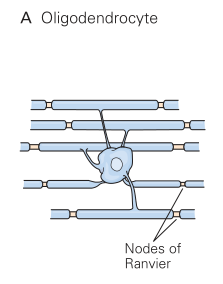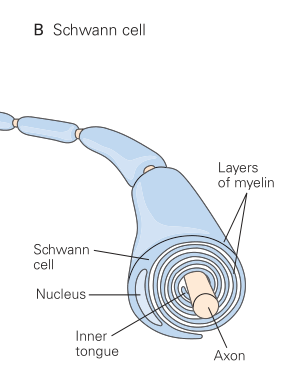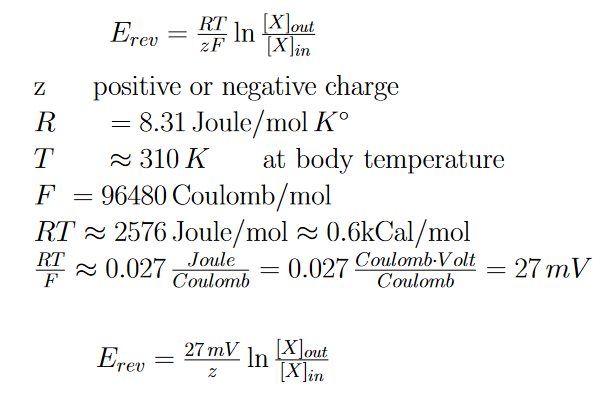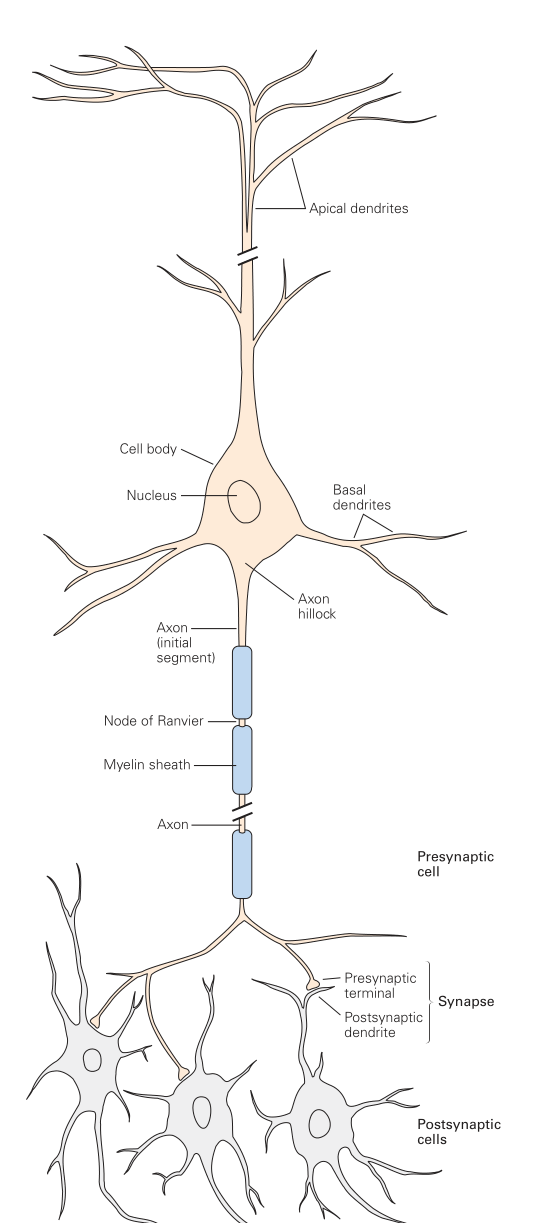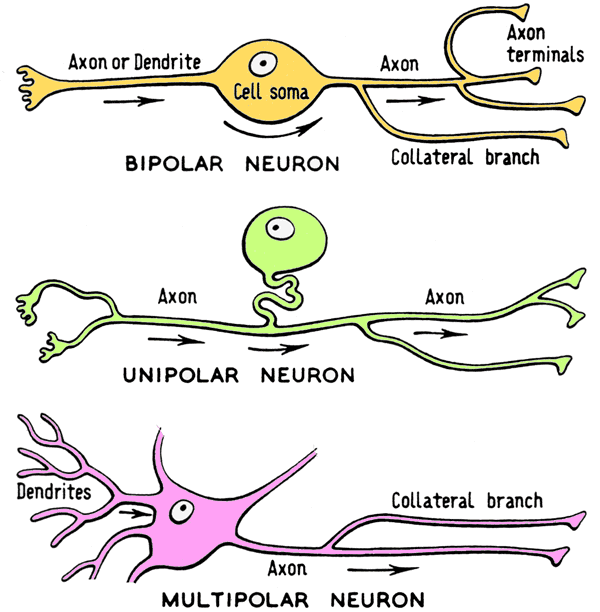Glossary
The following are terms to know in alphabetical order (not in an order that you should learn these concepts)
Central Nervous System (CNS)
A division of the nervous system that is comprised of the Brain and Spinal Cord.
CerebroSpinal Fluid (CSF)
A fluid that bathes the brain and spinal cord. It acts as a shock absorber and caries nutrients to nervous system cells and waste away from them. It is renewed by the body by volume about 4-5 times a day. It is separated from other bodily fluids by the Blood Brain Barrier (BBB).
Electrostatic force
The attraction or repulsion between charged particles, where oppositely charged particles.
Example: Negatively charged particles (Anions) are attracted to positively charged particles (Cations)
Diffusion
The tendency of 2 solutions of different concentrations separated by a permeable membrane, to equalize in concentration as particles from the area of high concentration will diffuse to the area of low concentration until Equilibrium. Resultant of the laws of entropy, and generally takes energy to counteract this effect (or other forces, such as interactions between charged particles).
ElectroChemical Gradient
The result of the forces of diffusion and the forces of Electrostatic force working together
Equilibrium
The state of rest when the net movement of particles passing one way through a membrane equals the particles passing through the other way, such that concentrations stay constant.
Equilibrium DOES NOT mean that particles stopped moving, NOR those it mean that the 2 separated concentrations are EQUAL, since forces such electrostatic forces (even between different ions) can change this equilibrium point away from the point of equal concentration
Glial Cells
While Glial cells develop from the same neural progenitor cells in the embryo and often share many characteristics of neurons, glial cells do not directly get involved in signaling in the sense that they are non-conductive. Glia support various functions of neurons. They may coat the axons of neurons to aid in signal transmission, release / absorb proteins to regulate signaling, or be involved in various process crucial for neural plasticity.
There are 2 kinds of glia cells: Macroglia and Microglia.
Macroglia Cells
These glia cells make up 90% of the glia cells in the human brain. They buffer some of the biochemical process in neurons and help clean up neurotransmitters at synapses. They are the ones you hear most often about and there are several major types:
- Oligodendrocytes
- Schwann Cells
- Ependymal Cells
- Involved in the production of CSF
- makes up the Lining of the BBB
- also line the ventricles of the brain
- have apical microvilli to increase surface area for diffusion
- have cilia to promote CSF movement
- capable of cleaning the CSF itself
- Astrocytes
- Star shaped, have lots of arms that support neurons and regulate signaling
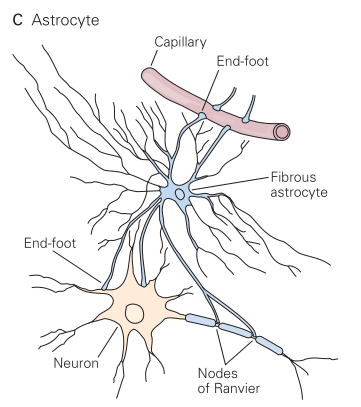
Principles of Neural Science - McGraw Hill (2021): Part 2 - Chapter 7- while not part of the BBB, they do help Ependymal cells
- modulate the milineu of the CSF
- Can take up potassium ions
- Regulates GABA and inactivated neurotransmitters
Microglia Cells
Generally thought of as the brains immune cells, are the first line of defense in the brain and spinal cord. While they can adapt to various phenotypes depending on their location and situation, they do have the following general tasks:
- Remove plaques, dead cells
- Remove Unnecessary neurons and synapses
- while this is especially true during brain development, they do still maintain this function afterwards. This is an active area of research!
- Destroy infectious agents
Ion Channels
Structures embedded in the phospholipid bilayer to allow charged ions to pass through, though often with some form of control, and falls under various classes, including (but not limited to):
- Random: known as leak / non-gated channels. Essentially no active control of having ions pass through
- Membrane Potential: Also known as voltage gated channels, can be toggled with changes to voltage across the membrane
- Ligand Gated Channels: Toggles channel based on the availability / absence of a chemical messenger
Milieu
Another term for "Environment", as in cellular environment / cellular Milieu
Nerst Equation
In the context of Neuroscience, this can be used to define the electrochemical equilibrium for a single particular ion across the cellular membrane. Can be used to find the Reversal Potential (also called the Nerst Potential), which is the electrical potential that balances against the concentration gradient.
Neuron
The basic nervous system cell responsible for receiving, processing, and outputting signals due to being electrically and chemically excitable and due to their asymmetric makeup.
Neurons are not the primary type of cell of the nervous system, they are outnumbered by Glial cells three to one!
(Principles of Neural Science - McGraw Hill (2021): Part 1 - Chapter 3)
The basic structure of a neuron consists of:
- Dendrites: Branches coming off the center cell body, are generally small but numerous, and act as the input for the neuron
- Cell body / Cell Soma: The 'Center' of the neuron, which is where the nucleus is contained
- Axon Hillock: The protrusion of the soma before it becomes the axon, where all input signals from the dendrites are combined where they may reach the firing threshold and trigger an action potential
- Axon: The output of the neuron, where action potentials flow out to other enervated neurons or receptor cells
There are hundreds of neuron types and they can be categorized in various manners:
There are hundreds of neuron types and they can be categorized in various manners:
Polarity
Neurons can be structured in slightly various manners to better fit their specific role. They can be Bipolar, Unipolar, or Multipolar.
Afferent / Interneuron / Efferent
Names of categories referring to the general functional role of a neuron.
- Sensory / Afferent: Receives data from the outside world.
- Tend to be unipolar or bipolar.
- Example: Photo-receptor.
- Interneuron: Neurons that connect to other neurons. Does not receive input from the world, nor directly control any response. Are typically involved in information processing.
- Tend to be multipolar.
- Example: Most of the neurons in the brain.
- Motor / Efferent: Outputs a response to the outside world. Typically to a muscle but potentially also to things like glands.
- Tend to be multipolar.
- Cell body is often found in the spine
- Example: Nerve innervating a muscle
Peripheral Nervous System (PNS)
A division of the nervous system, composed of nerves that branch out from the CNS (like out of the spinal cord). Basically anything part of the nervous system that isn't the Brain or Spinal Cord themselves.
Phospholipid Bilayer
The structure of most cell membranes, include of Neurons.
- Is difficult for charged ions to pass through directly
- They must use (often controllable) channels
- Small non-polar molecules like CO2 and O2 can pass directly through the bilayer, larger ones sometimes can slowly
-
- some polar molecules can slowly pass through, like water
- Water usually passed through Aquaporin Pores
- some polar molecules can slowly pass through, like water
- Larger molecules often require the aid of structures to pass through
-
The Phospholipid Bilayer is composed primarily of Phospholipid molecules.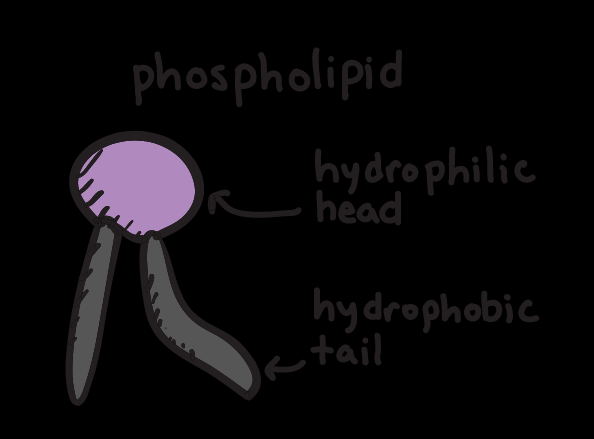
The bilayer is composed of two layers of these phospholipids, with the hydrophilic head facing the outside / inside environments and the hydrophobic fatty acid tail being within the layer sheet.
- This makes sense, since the hydrophilic head prefers aqueous environments, this is a self organizing structure!
- The centered hydrophobic tails make it difficult for water to pass through the bilayer directly
- Cholesterol is also a big component of the cell membrane. It accomplishes several tasks, such as maintaining membrane "fluidity" across a wide temperature range, and also can help as a glue keeping phospholipids together.
Voltage / Potential
Voltage is a measure of 'pressure' of the electrical force from one area to another.
Examples:
- Batteries use chemistry to create a voltage differential between 2 ends of the battery cell
- Neurons use ion gradients (not chemistry!) across the cell membrane
In neurons, when measuring the voltage, we always use the outside of the cell as ground measurement
'Potential' is often used as a synonym for Voltage
There are some potentials to know about:
- Resting Potential:

